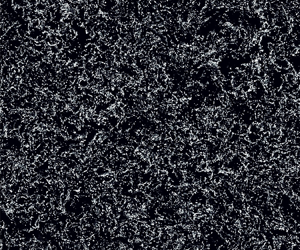No CrossRef data available.
Published online by Cambridge University Press: 26 November 2024

Heavy particles suspended in turbulent flow possess inertia and are ejected from violent vortical structures by centrifugal forces. Once piled up along particle paths, this small-scale mechanism leads to an effective large-scale drift. This phenomenon, known as ‘turbophoresis’, causes particles to leave highly turbulent regions and migrate towards calmer regions, explaining why particles transported by non-homogeneous flows tend to concentrate near the minima of turbulent kinetic energy. It is demonstrated here that turbophoretic effects are just as crucial in statistically homogeneous flows. Although the average turbulent activity is uniform, instantaneous spatial fluctuations are responsible for inertial-range inhomogeneities in the particle distribution. Direct numerical simulations are used to probe particle accelerations, specifically how they correlate to local turbulent activity, yielding an effective coarse-grained dynamics that accounts for particle detachment from the fluid and ejection from excited regions through a space- and time-dependent non-Fickian diffusion. This leads to cast fluctuations in particle distributions in terms of a scale-dependent Péclet number  ${\textit {Pe}}_\ell$, which measures the importance of turbulent advection compared with inertial turbophoresis at a given scale
${\textit {Pe}}_\ell$, which measures the importance of turbulent advection compared with inertial turbophoresis at a given scale  $\ell$. Multifractal statistics of energy dissipation indicate that
$\ell$. Multifractal statistics of energy dissipation indicate that  $ {\textit {Pe}}_\ell \sim \ell ^\delta /\tau _{p}$ with
$ {\textit {Pe}}_\ell \sim \ell ^\delta /\tau _{p}$ with  $\delta \approx 0.84$. Numerical simulations support this behaviour and emphasise the relevance of the turbophoretic Péclet number in characterising how particle distributions, including their radial distribution function, depends on
$\delta \approx 0.84$. Numerical simulations support this behaviour and emphasise the relevance of the turbophoretic Péclet number in characterising how particle distributions, including their radial distribution function, depends on  $\ell$. This approach also explains the presence of voids with inertial-range sizes, and the fact that their volumes have a non-trivial distribution with a power-law tail
$\ell$. This approach also explains the presence of voids with inertial-range sizes, and the fact that their volumes have a non-trivial distribution with a power-law tail  $p(\mathcal {V}) \propto \mathcal {V}^{-\alpha }$, with an exponent
$p(\mathcal {V}) \propto \mathcal {V}^{-\alpha }$, with an exponent  $\alpha$ that tends to 2 as
$\alpha$ that tends to 2 as  ${\textit {Pe}}_\ell \to 0$.
${\textit {Pe}}_\ell \to 0$.